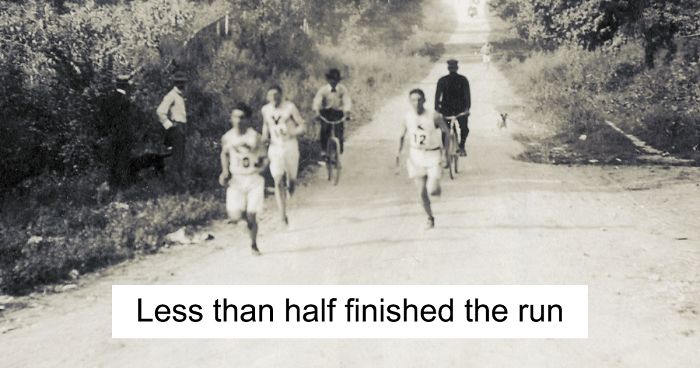Hello ladies and gents this is the Viking telling you that today we are talking about
1904 MEN'S MARATHON
The men's marathon at the 1904 Summer Olympics in St. Louis, United States, took place on August 30 of that year, over a distance of 24.85 miles (39.99 km). Thirty-two athletes representing four nations competed, but only 14 managed to finish the race, which proved to be a bizarre affair due to poor organization and officiating.
This was the third appearance of the marathon event, which is one of 12 athletics events to have been held at every Summer Olympics. Arthur L. Newton of the United States was the only runner from 1900 to return. Other significant American runners included the winners of the past three Boston Marathons: 1902 winner Sammy Mellor, 1903 winner John Lordon, and 1904 winner Michael Spring. Top foreign runners did not travel to St. Louis for the event.
Cuba and South Africa each made their first appearance in the event. The United States was the only nation to have runners in each of the first three Olympic marathons.
The marathon included the first two black Africans to compete in the Olympics: two Tswana tribesmen named Len Tau and Jan Mashiani who happened to be in St. Louis as part of the South African exhibit at the 1904 World's Fair. Both had served as long-distance message runners during the then-recent Boer War. Although some accounts report that both ran barefoot, Mashiani was shoed in photographs taken during the event.
The marathon distance had not yet been standardized; in St. Louis, the course was 24.85 miles (39.99 km). St. Louis organizers started the marathon at 3 pm in the afternoon, while most contemporary marathons start in the early morning to take advantage of cooler times of day.
The start included five laps around the stadium track. The rest of the course was on dusty country roads with race officials riding in vehicles ahead of and behind the runners, creating dust clouds that exacerbated the severely hot and humid conditions. At start time, the temperature was around 90 degrees Fahrenheit (32 degrees Celsius). The course eventually ended back in the stadium.
The first to arrive at the finish line was Fred Lorz, who had actually dropped out of the race after nine miles, suffering from cramps, and hitched a ride back to the stadium in a car, waving at spectators and runners alike during the ride. When the car broke down at the 19th mile, Lorz re-entered the race and jogged across the finish line.
After being hailed as the winner, he had his photograph taken with Alice Roosevelt, daughter of then-U.S. President Theodore Roosevelt, and was about to be awarded the gold medal when his subterfuge was revealed. Upon being confronted by officials, Lorz immediately admitted his deception, and despite his claims he was joking, the AAU responded by banning him for a year. He later won the 1905 Boston Marathon.
Thomas Hicks ended up the winner of the event, although he was aided by measures that would not have been permitted in later years. Ten miles from the finish, Hicks led the race by a mile and a half, but he had to be restrained from stopping and lying down by his trainers. From then until the end of the race, Hicks received several doses of strychnine (a common rat poison, which stimulates the nervous system in small doses) mixed with brandy.[4] He continued to battle onwards, hallucinating, barely able to walk for most of the course. When he reached the stadium, his support team carried him over the line, holding him in the air while he shuffled his feet as if still running. Hicks had to be carried off the track, and might have died in the stadium had he not been treated by several doctors. He lost eight pounds during the course of the marathon.
Another near-fatality during the event was William Garcia of the United States. He was found lying in the road along the marathon course with severe internal injuries caused by breathing the clouds of dust kicked up by the race officials' cars. Sam Mellor, who had won the 1902 Boston Marathon, was also overcome by dust and, despite having led the field at the halfway mark, was forced to drop out of the race.
Five-foot tall Cuban postman Andarín Carvajal joined the marathon, arriving at the last minute. After losing all of his money gambling at dice in New Orleans, he hitchhiked to St. Louis and had to run the event in street clothes that he cut around the legs to make them look like shorts. Not having eaten in 40 hours, he stopped off in an orchard during the race to snack on some apples, which turned out to be rotten.
The rotten apples caused him to have strong stomach cramps and to have to lie down and take a nap. He also spent time chatting with spectators and playfully stole some peaches from a race official. Despite falling ill from the apples and taking a nap, he finished in fourth place. Many felt he could have won and set a new record if not for the delays.
The South African entrants, Len Tau and Jan Mashiani, finished ninth and twelfth, respectively. This was a disappointment, as many observers were sure Len Tau could have done better if he had not been chased nearly a mile off course by feral dogs.
Arriving without correct documents, Albert Corey, a French immigrant to the United States, is inconsistently listed as performing in a mixed team in the four mile team race (with four undisputed Americans) and performing for the US in the marathon and as always have a chilled day from the Viking

Comments
Post a Comment